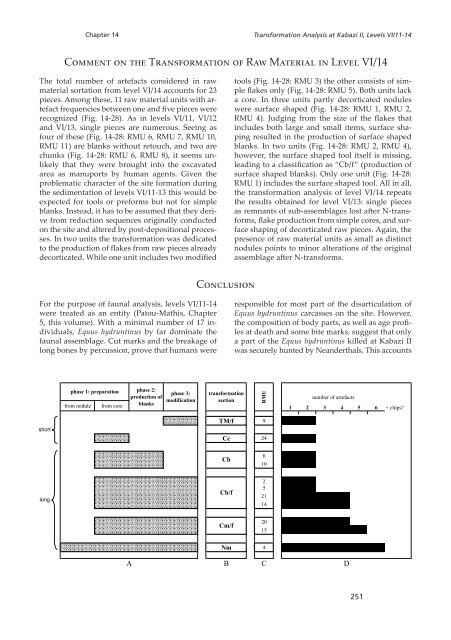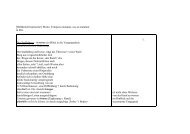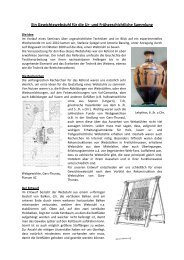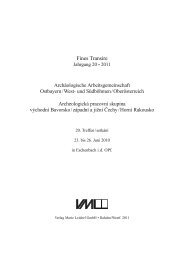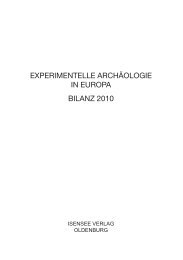Thorsten Uthmeier & Jürgen Richter
Thorsten Uthmeier & Jürgen Richter
Thorsten Uthmeier & Jürgen Richter
Create successful ePaper yourself
Turn your PDF publications into a flip-book with our unique Google optimized e-Paper software.
Chapter 14<br />
The total number of artefacts considered in raw<br />
material sortation from level VI/14 accounts for 23<br />
pieces. Among these, 11 raw material units with artefact<br />
frequencies between one and five pieces were<br />
recognized (Fig. 14-28). As in levels VI/11, VI/12<br />
and VI/13, single pieces are numerous. Seeing as<br />
four of these (Fig. 14-28: RMU 6, RMU 7, RMU 10,<br />
RMU 11) are blanks without retouch, and two are<br />
chunks (Fig. 14-28: RMU 6, RMU 8), it seems unlikely<br />
that they were brought into the excavated<br />
area as manuports by human agents. Given the<br />
problematic character of the site formation during<br />
the sedimentation of levels VI/11-13 this would be<br />
expected for tools or preforms but not for simple<br />
blanks. Instead, it has to be assumed that they derive<br />
from reduction sequences originally conducted<br />
on the site and altered by post-depositional processes.<br />
In two units the transformation was dedicated<br />
to the production of flakes from raw pieces already<br />
decorticated. While one unit includes two modified<br />
Transformation Analysis at Kabazi II, Levels VI/11-14<br />
C������ �� ��� T������������� �� R�� M������� �� L���� VI/14<br />
For the purpose of faunal analysis, levels VI/11-14<br />
were treated as an entity (Patou-Mathis, Chapter<br />
5, this volume). With a minimal number of 17 individuals,<br />
Equus hydruntinus by far dominate the<br />
faunal assemblage. Cut marks and the breakage of<br />
long bones by percussion, prove that humans were<br />
short<br />
long<br />
C���������<br />
tools (Fig. 14-28: RMU 3) the other consists of simple<br />
flakes only (Fig. 14-28: RMU 5). Both units lack<br />
a core. In three units partly decorticated nodules<br />
were surface shaped (Fig. 14-28: RMU 1, RMU 2,<br />
RMU 4). Judging from the size of the flakes that<br />
includes both large and small items, surface shaping<br />
resulted in the production of surface shaped<br />
blanks. In two units (Fig. 14-28: RMU 2, RMU 4),<br />
however, the surface shaped tool itself is missing,<br />
leading to a classification as “Cb/f” (production of<br />
surface shaped blanks). Only one unit (Fig. 14-28:<br />
RMU 1) includes the surface shaped tool. All in all,<br />
the transformation analysis of level VI/14 repeats<br />
the results obtained for level VI/13: single pieces<br />
as remnants of sub-assemblages lost a�er N-transforms,<br />
flake production from simple cores, and surface<br />
shaping of decorticated raw pieces. Again, the<br />
presence of raw material units as small as distinct<br />
nodules points to minor alterations of the original<br />
assemblage a�er N-transforms.<br />
responsible for most part of the disarticulation of<br />
Equus hydruntinus carcasses on the site. However,<br />
the composition of body parts, as well as age profiles<br />
at death and some bite marks, suggest that only<br />
a part of the Equus hydruntinus killed at Kabazi II<br />
was securely hunted by Neanderthals. This accounts<br />
phase 1: preparation<br />
phase 2:<br />
phase 3: transformation<br />
production of<br />
number of artefacts<br />
modification section RMU<br />
from nodule from core blanks<br />
1 2 3 4 5 6 + chips?<br />
TM/f 9<br />
Cc 24<br />
Cb<br />
Cb/f<br />
Cm/f<br />
6<br />
10<br />
2<br />
5<br />
21<br />
14<br />
20<br />
15<br />
Nm 4<br />
A B C<br />
D<br />
251


